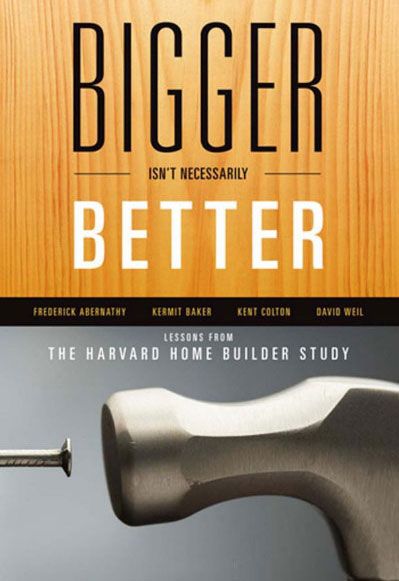
Today I had the chance to sit in on a conference call with the authors of Bigger Isn’t Necessarily Better (Lexington Books, November 30, 2011) a book based on the Harvard Builder Study comparing the performance and operations of mid- to large US homebuilders during the great building boom of the early 2000s. The book examines the operational side of the industry instead of financial performance, and provides a revealing look at how little progress mid- to large homebuilders made in improving their jobsite coordination and control, despite the rise of hugely profitable national companies, the kind you would expect to implement the most advanced operational systems, like automakers and large retailers have. To facilitate useful comparisons the authors narrowed their analysis to entry-level home divisions, avoiding comparisons between various price points.
In short, the authors found that major homebuilders did not adopt innovations in areas ranging from information technology, supply-chain practices, and work-site management, nor improve their operational performance. In theory, the largest builders were supposed to better the industry through applying the most basic, industrial best practices, such as total quality management (TQM), which would trickle down to subcontractors and smaller builders, closing a “virtuous circle,” as researchers described the equation. But the big builders in many cases didn’t even bother to estimate jobs, they let the subs make all the choices on methods and materials, they didn’t capture productivity advantages, such as speed and cost control. In fact, the study revealed that the smaller the builder, the better chance the builder had a more sophisticated and controlled operation, which allowed smaller (meaning 500 home a year) builders to compete in regional markets by shear virtue of construction site control and efficiency, even without the financial clout. Given this, the book discusses what homebuilders can learn from other industries that they seem to ignore, such as bar codes and inventory control, as we all face a challenging future in housing.
Large builders did have advantages that included sophisticated land acquisition strategies, lots of money, and marketing acumen. The corresponding lack of attention to jobsite management was blamed on lack of skilled labor, local building methods that made standardization difficult across multiple divisions, and the fact that large builders grew through acquiring smaller builders and continued to rely on inherited management software and communications rather than upgrading new divisions to a corporate platform. You know how difficult this process can be if you’ve had the misfortune of banking with a local bank acquired by a national firm, for a while, all systems run haywire.
But development is primarily an opportunity business, and not based on operations. While you’re standardizing the scheduling and communications software, the market could change, and the slowdown in operations becomes costly. Now that we face a very different market and everyone has slowed down, and reduced output, we have to mine the construction site for profit, and quality.
To my disappointment, the study focused exclusively on lost opportunities in reaping production-related profits, and not at all on the consequence of building blind in the quality of homes the national behemoths constructed. A similar blind-spot derailed the US auto industry as consumers began to buy more reliable and better constructed imports. Ford responded with “Quality is Job One,” and later the rest of the US automakers caught on, and began to modernize and upgrade operations, not just to reduce costs, but to do a better job. This yielded American cars we can be proud of, again, and the painful admission of how close we came to losing our national auto industry with the tongue-in-cheek Chrysler Eminem Super Bowl Commercial – Imported from Detroit – at this year’s Super Bowl.
If our national homebuilders had European and Asian competition, you’d find the same disheartening results. But if you read the article Rob Yagid and I wrote after interviewing about 50 of today’s most successful builders, Incorporating Best Practices (Nov 10, 2011), you’ll see that a sharp focus building science and best practices not only yields a better house, but a more efficient jobsite. As the housing market slowly returns to normal, and there are many signs that it will, your focus on incorporating best practices will allow you compete with any size builder, not just in quality and customer service, but construction costs, too. Bigger isn’t Necessarily Better helped me understand why the national builders I competed with were not achieving construction costs much better than I could with a very small operation.
Got a specific business question? Leave a comment below, or ask for advice from other experienced builders in the Breaktime business forum.
Plus, read more articles from the Building Business blog.
Fine Homebuilding Recommended Products
Fine Homebuilding receives a commission for items purchased through links on this site, including Amazon Associates and other affiliate advertising programs.

Reliable Crimp Connectors

Handy Heat Gun

8067 All-Weather Flashing Tape

Examining the experience of companies in other industries, from autos to computers to retail, Bigger Isn't Necessarily Better provides insight into how American home builders might better cope with operational challenges going forward.

























View Comments
"But if you read the article Rob Yagid and me wrote after interviewing about 50 of today's most successful builders, Incorporating Best Practices (Nov 10, 2011), you'll see that a sharp focus building science and best practices not yields a better house, but a more efficient jobsite."
You may want to review the last paragraph for grammar and other writing best practices.
Thanks Ktkcad! point taken and error corrected.Blogs, unlike articles, don't go through an editing process, mixed blessing. Appreciate you reading and taking the time to write a comment.
Thank you Fernando, for another helpful blog.